2018 – The Year of Augmented Humanity

Isobar predicts that 2018 will be the year of Augmented Humanity, a year where technology enhances and scales our most human attributes. In 2018, technological interfaces will become more natural and instinctive, technology will automate repetitive tasks to free up time for creativity and compassion, and artificial intelligence will meet emotional intelligence.
Isobar’s innovation and strategy experts from around the world have defined five key trends that explore this evolving relationship between humanity and technology and predict a harmonious future. Augmented Humanity explores the ways in which technology enhances and fuels our most human attributes – the ability to recognise and trust each other, to adapt to changing circumstances and the power to deliver true creativity.
Artificial intelligence is great, but humans score on emotional intelligence. The power of being human is in empathy. This cannot be automated or outsourced. Augmented Humanity will use technology to scale everything that is best and most powerful about human interaction.”- Jean Lin, Isobar’s Global CEO.
The report argues that we may one day view the era of anonymous, one size fits all transactions as a temporary blip in our evolution, and that as technology advances it will become more human, not less. It will return us to a time where voice will be the primary way we interact with the world, where we will be recognised and rewarded in stores, and where we will buy more directly from trusted suppliers.

source: medium
Isobar’s five key trends for 2018 explore this intersection of technology and humanity, magic and the machine, code and conscience:
1. Body Talk explores the body as an interface, as our eyes and ears replace touching and tapping.
2. Powered by People tackles the shift from customers to communities as technology turbocharges the sharing economy.
3. The Economy of Me looks at the power of AI to deliver ever more personalised products, prices and places.
4. The Ethical Algorithm tackles technology as a force for good; in a world of fake news and algorithm bias is there such a thing as moral code?
5. The Makers and the Machines explores the extraordinary union of art and technology to create outputs we could never before imagine.
You can download the report here.
How Can Location Data Help You Grow Your Business
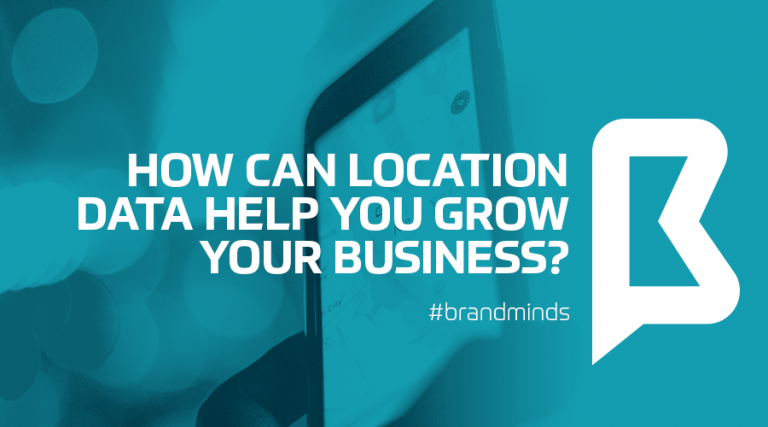
The importance of data is growing daily and its impact on the businesses as well. Gathered and used in smart ways it can help you reach the right audience, in the right way. In other words, it’s a known fact that location intelligence has become a fundamental part of some of the most successful businesses in the world today. Tough economic times and the advancement of new technology in recent years have massively pushed the need for businesses to gain more transparent and competitive insights on their performance and opportunities.
According to geovation.uk, location provides meaningful context. It can identify essential relationships between geography and consumer experiences, products and services. Location intelligence answers important questions, such as ‘where are my most valuable customers?’, ‘where are the issues impacting my supply chain?’ Location intelligence can detect clusters and patterns of events, make predictions, and provide the basis on which to make better business decisions.
Knowing the location of users, employees and company assets is becoming a vital part of many businesses in order to act efficiently and make informed decisions. From helping customers locate relevant amenities (e.g. Foursquare, Tripadvisor) to logistics companies optimizing delivery routes (UPS, Hermes), location, spatial data and digital mapping are playing a pivotal role in these business functions.
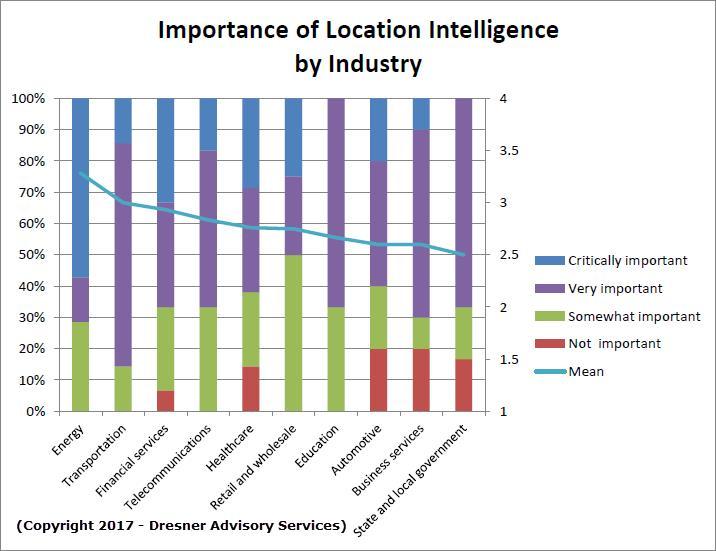
At the same time, location represents a great manner of revealing relationships between data sets that might not have otherwise been obvious and, through location analytics, arrive at great insights.
Worries about concerns like user privacy and data quality are valid: Know that it’s important to source location-informed insights from opt-in data that is thoroughly cleansed and, most importantly, aggregated and anonymized (the Location Search Association recently published a valuable landscape report analyzing the key providers in the space). Be sure to work with a data provider that adheres to emerging industry best practices, including use of data sourced only from apps with specific user opt-in (like Apple is now mandating), and complies with country-specific regulations, like GDPR. – entrepreneur.com
Data company Carto partnered with market research firm Hanover Research on a February 2018 study called “The State of Location Intelligence 2018,” surveying more than 200 C-level executives about the ways their companies are using location data to identify new consumer markets, improve marketing strategies and improve customer service. Here are some of their main findings:
- 66% of respondents said that Location Intelligence was “Very” or “Extremely” important today for their businesses, 78% said it would be in the next year, and 85% said it would be in the next three years.
- Only 27% said that they use any kind of custom geography and 17% use block groups. To understand location data, businesses must begin visualizing and analyzing at a deeper geographic level.
- Nearly all C-level and management level respondents,especially those from small to mid-sized organizations, note a strong likelihood to invest in Location
Intelligence within the next one (78%) to three years (84%). - Companies are very interested in finding data scientists that understand how to manipulate spatial data effectively, and conducting iterative spatial analysis is the most important step in applying Location Intelligence.
- “Ensuring data quality and accuracy” (49%), “gathering data real time” (40%), and “extracting data from existing systems in a usable way” (39%) are more commonplace challenges in terms of data collection.
Taking a closer look at these data, we can see for sure that if you know how to tap into the Location Intelligence right, your business can have a bright future and even expand, especially because many aren’t already using it at its full potential.
Therefore, how can you do more and be ahead of the rest? Entrepreneur.com is giving you some ideas:
- Use the big potential that research is offering you. “Location data can provide a stronger context of your target audience to better activate consumers. Beyond just marketing what you already have, it can also help reveal opportunities for products or services that you’ve not yet developed or marketed.”
- Competitive Intelligence. “This wealth of insight about where people go in the real world and, in particular, how they interact with your competition, is invaluable intelligence to your business and can help inform decisions about everything from pricing and inventory to in-store promotions and staffing levels.”
- Acquisition and investments. “Asset managers are increasingly turning to location data to inform their investments, according to a recent report from Optimas. Given this trend, location data should most definitely be part of your due diligence when evaluating any prospective investment or acquisition. Evaluate the foot traffic patterns in and around the business you’re considering and think about what it might reveal.”
More on the subject, tap here.
Inspirational study cases one can find in this Forbes article.
France and Germany to support the tech start-ups
France and Germany want to build an European Union-wide initiative to fund innovation and research in tech start-up projects across the bloc so that EU can compete more effectively against the tech companies of the United States and China, according to Reuters.
Berlin and Paris called for the European Innovation Council to fund “ambitious” technology start-ups in a paper presented to European Union leaders at the Balkan summit last week.
“A joint effort is also needed to further improve the venture capital environment and regulations to allow successful market transfer of breakthrough innovations, as well as the foundation and growth of disruptive deep technology companies in Europe,” the paper said, according to Reuters.
France and Germany are pushing for reforms in various sectors before a summit of EU leaders in June. At the same time, they say the aim is to create a network to bring breakthrough innovations in science to the marketplace and to open up the network to other interested EU countries.
France and Germany want national initiatives to be complemented by EU ones, which can have more added value for the establishment and the growth of tech start-ups, the paper said. The two countries want their project to focus on tech leaders in academia as well as entrepreneurs and to provide funding for high-risk tech projects.
According to pymnts.com, France has already promised to spend 1.5 billion euros ($1.75 billion) on artificial intelligence by 2022.
There are also companies committing to help the EU grow in the technology sector. Last year, for example, Samsung’s venture capital arm announced it will use a $150 million global funding round to invest in early-stage startups in Europe for investment or acquisition, focusing on tech companies working on artificial intelligence, the Internet of Things, augmented reality and virtual reality.- pymnts.com
Video On Demand and Its Impact On the TV
The most recent research from the Video Advertising Bureau (VAB) shows that live TV is still king, with the majority of viewers watching their favorite programs live, rather than time-shifting, or watching them after they’ve already aired. According to AdWeek, the report also found that 81 percent of viewers who binge video-on-demand (VOD) programming say they can view it at a time that is convenient for them. As a result, VOD ad impressions increased nearly fourfold, to 23.3 billion in 2017 from 6.3 billion in 2014.


“While live TV remains the first choice for TV viewing regardless of time of day, it’s clear consumers enjoy custom designing their viewing experience to access more content, catch up on missed episodes and binge-watch at their convenience,” said Sean Cunningham, president and CEO, VAB,quoted by AdWeek. “[The research proves] TV isn’t going away—it’s everywhere.”

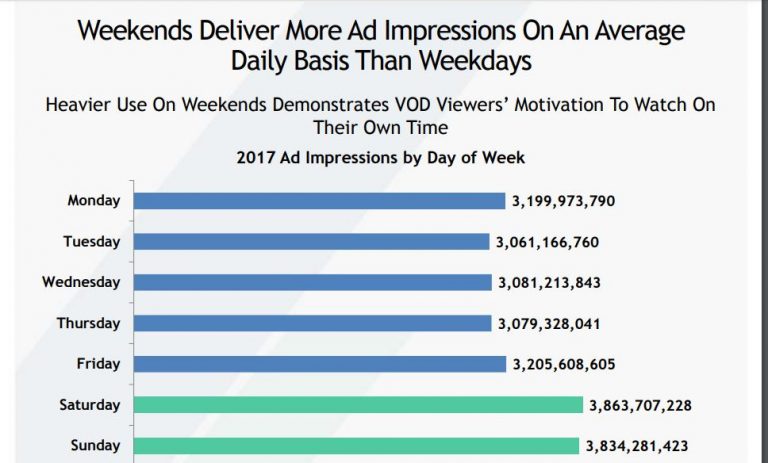
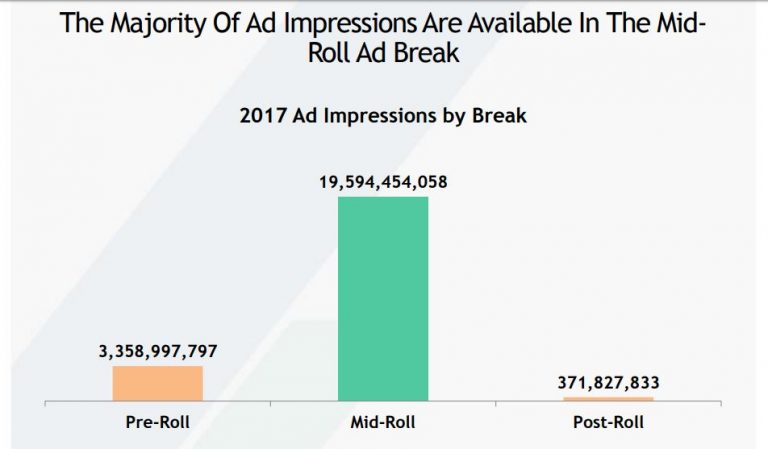
Slides’ source: VAB
Color Psychology in Marketing and Its Importance in Driving Sales
Research shows that the proper use of color increases brand recognition by 80%. It also raises the visual appearance by 93%. A further 85% of consumers buy because of color.
In the case of affordability, the visual appeal of an item is the major influence on a consumer’s buying decision. “In fact, the color, make, look and feel of a product affects 93% of the buying decision. This is followed by texture which affects 6% of the buying decision and sounds and smell which affect 1% of the buying decision. Once a consumer starts walking towards an item that has his or her favorite color, the major part of the purchasing decision has already been made. When the four: color, design/texture, and smell are combined, the buying decision becomes powerful,” wrote colorpsychology.org.
Color psychology is an area of research that looks at how color influences our behavior and decision-making. When used in marketing, for example, different colors can impact the way buyers perceive a brand in ways that aren’t always apparent, such as how certain hues can increase appetite.

4 top rules to increase your sales
Color is too dependent on personal experiences to be universally translated to specific feelings. There are, however, broader messaging patterns to be found in color perceptions.
In a study titled “Impact of color on marketing,” researchers found that up to 90% of snap judgments made about products can be based on color alone, depending on the product. Regarding the role that color plays in branding, results from another study show that the relationship between brands and color hinges on the perceived appropriateness of the color being used for the particular brand (does the color “fit” what is being sold?).
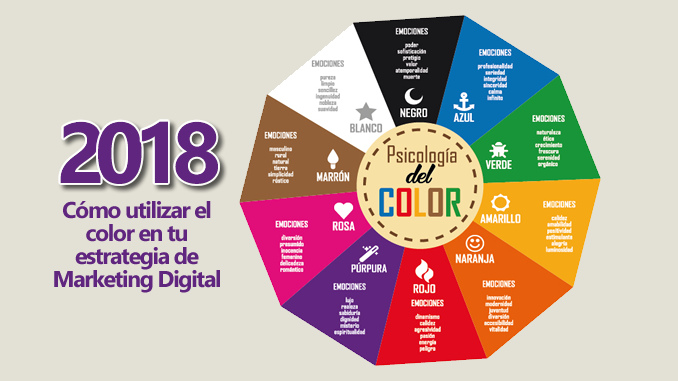
source: Marketing Digital Blog
The study Exciting Red and Competent Blue also confirms that purchasing intent is greatly affected by colors due to the impact they have on how a brand is perceived. This means that colors influence how consumers view the “personality” of the brand in question.
When it comes to picking the “right” color, research has found that predicting consumer reaction to color appropriateness in relation to the product is far more important than the individual color itself.
Psychologist and Stanford professor Jennifer Aaker found in her study “Dimensions of Brand Personality” that there are five core dimensions that play a role in a brand’s personality: sincerity, excitement, competence, sophistication and ruggedness.
“Brands can sometimes cross between two traits, but they are mostly dominated by one. While certain colors do broadly align with specific traits (e.g., brown with ruggedness, purple with sophistication, and red with excitement), nearly every academic study on colors and branding will tell you that it’s far more important for colors to support the personality you want to portray instead of trying to align with stereotypical color associations,” wrote helpscout.net.
At the same time there are difference between how men and women perceive them. Additional research in studies on color perception and color preferences show that when it comes to shades, tints and hues men seem to prefer bold colors while women prefer softer colors. Also, men were more likely to select shades of colors as their favorites (colors with black added), whereas women were more receptive to tints of colors (colors with white added).
More pieces of information on the subjects you can find here and here.
Wingly – the Airbnb of flights

2017 proved to be a really good year for Airbnb as the company “blew by its own internal forecasts to bring in $93 million in profit on $2.6 billion in revenue”, as reports Bloomberg’s Olivia Zaleski. The 2017 year marks the first full year of generating income for the San Francisco-based company, which became profitable in the second half of 2016, as it managed to defy some of the disruptions in global travel last year.
The Airbnb story has been an inspiration from its beginnings. The company began in 2007 when roommates Brian Chesky and Joe Gebbia started AirBed & Breakfast on the living room floor of their San Francisco apartment. The friends provided three air mattresses and homemade breakfast to guests who were unable to find alternative accommodation in the city. In 2008, Nathan Blecharczyk joined AirBed & Breakfast and Airbedandbreakfast.com was launched (the website name was shortened to Airbnb.com shortly afterwards). In 2011, the company started its overseas expansion, opening its first international office in Hamburg, Germany.
More statistics about Airbnb you can find here.
Taking inspiration from its success, Wingly, a flight sharing platform connecting private pilots with passengers to share the cost of a flight,became the winner of TechCrunch’s Startup Battlefield Europe 2018.
Wingly aims to connect aviators with amateurs like me who need to get from A to B but have some flexibility about where A and B happen to be, and can work around the pilot’s timing. For the passenger it promises an exhilarating experience along with transportation. And for the pilot? Carrying one or more passengers helps keep the cost of their indulgence down. It’s the Airbnb of aviation.

You can also bid for a flight — saying roughly where you need to be, and when, and hoping that one of the flying community is willing to help.
The organisation also requires a scan of your passport, even if you are going no further than the west of England. Unlike commercial flights, you have to specify your weight, and that of your baggage, in advance, so the pilot can make weight-and-balance calculations. It currently offers thousands of flights throughout Europe, and is also opening up routes in the Caribbean.
Both pilots and passengers have the option to review each other and the experience once the flight is over. Pets are permitted as long as the pilot you’re flying with allows them, and flights can be cancelled or rescheduled in poor weather conditions.
How it works is that pilots post their planned route, amount of seats available and cost-sharing price on the app. Passengers book if interested and depart from a private airfield on the day. Potential passengers can also request trips that are not currently listed, and if a pilot sees a proposed route that works for them, they can get in contact and arrange it. Wingly also offers sightseeing flights that allow passengers to enjoy a beautiful landscape from the sky, or excursion flights for a day trip or weekend away. – Lonely Planet
In March this year, Wingly closed a seed funding round of €2 million to strengthen its leader position on the European market and expand in new countries. Only 8 months after receiving its certification to operate all over Europe, well known angel investors such as Philipp Rösler (former vice chancellor of Germany and private pilot) or Stephane Mayer (former CEO of Daher Socata & ATR, private pilot) invested in this round alongside the VC fund Howzat Partners.
Wingly was founded in 2015 and is based in Paris, Berlin and London. With the fresh capital the young company wants to double its size and grow to a team of around 30 people to scale and develop its technology to new markets.
Instagram Shadowbanning and How To Avoid It
According to PetaPixel, Instagram has been accused of “shadowbanning” users and posts starting about a year ago, preventing tagged content from properly appearing in searches for those tags. “After photographers and others complained last year, someone made a tool for checking to see if you’ve been shadowbanned. Now there’s a new and improved one: Triberr’s Instagram Shadowban Test. Triberr, a company that develops a content marketing automation suite, created the tool to provide Instagram users with a more comprehensive look at whether their photos and posts are showing up correctly for other Instagram users,” added Michael Zhang for the publication.
“The shadowban applies to individual posts and may occur for various reasons,” Triberr writes. “For example, overuse of a hashtag or a banned hashtag can trigger this occurrence. Therefore, we provide an analysis of your latest 10 posts so that you can easily identify culprits in your posts.” If a hashtag is found to contain the photo, it shows up as green in the results. If a hashtag was not found associated with the photo, it shows up as red and the post failed the test.
What happens is that the shadowban removes the ability of your posts to be seen by anyone but your current followers. Hashtags become next-to-useless because non-followers will not be able to discover your hidden content, even if they search a specific hashtag.
As the easiest way to avoid getting there is following Instagram’s posting best practices and focus on creating and sharing non-promotional, authentic content, we also have some others ideas that can help you along the way:
Engage authentically with your community
Show that you are a real person and have a real personality. Engage and act creatively. Like and comment on content you truly enjoy and follow only those accounts that you’re interested in following. Doing it naturally and having a certain rhythm or pattern all the time in your actions will not catch spam filters’ attention.
Avoid being reported
Being reported isn’t an automatic Shadowban. Instagram will check out your profile to make sure your account isn’t violating their Terms of Service and determine from their. If you’re found at-fault Instagram may shadowban you or even fully disable your account.
Stay in the normal limits
According to Social Media Examiner, the limit of accounts you can follow is 7,500 accounts. Once you hit that limit, you will have to unfollow someone to be able to follow someone new. Instagram also has fairly strict limits as to the number of people you can follow within a certain time period, although a few factors impact this number. “Newer accounts have lower limits on the number of accounts they can follow hourly or daily. The size of your account (the number of people following you) may also contribute to the limit you can reach. Again, some people may be allowed to exceed these limits, depending on various account factors including engagement on their own account content. But pushing these limits puts you at risk of exceeding allowances and having your account put on restriction for a minimum of 24 hours,” wrote Social Media Examiner.
Moreover, at the same time, there are similar limits to the number of accounts you can unfollow in an hour or day.
Direct message to groups at maximum 15 people
As the new rules say, one can send a direct message to a single user or a group of up to 15 people. Each direct message can contain up to 500 characters. When you reach that cap, no more characters will appear in the text.
Don’t use bots and third party apps to help you manage your account
Using a bot to analyze your engagement or to help you with unfollowing inactive accounts may hold a chance for your account to be shadowbanned.
Use different hashtags on your posts
Make sure you change the hashtags you usually use daily. Don’t just copy paste your hash-tags and post them for every picture!
Here you can find a list of blocked hashtags
The Main 10 Tricks Any Marketer Should Know
Working in marketing may be one of the most beautiful jobs on Earth as it keeps you always up-to-date with the new trends in the market and is a very fast paced industry. At the same time, receiving some new ideas and points of view comes handy from time to time, therefore we decided to offer you some tricks that we believe will never get old.
1.Load up on data fast. “Facebook advertising can deliver the cheapest CPM’s in online marketing with the ability to test ad efficiency in real-time. Use the power editor “duplicate” tool to create hundreds of ads and change one element per ad. Give these a small budget, and you’ll quickly see what works and what doesn’t without breaking the bank. Double down on the ones that work, and kill the ones that don’t.” – Kyle Ivins, co-founder Envolve Agency for Entrepreneur.com
2.Reduce your subject lines to only one word and get an immediate lift in email marketing. Make sure that you choose that word carefully, as it should create curiosity, while at the same time remain relevant to your message.
3.Watch your competitors’ mentions. You can start by creating a Google Alert for your competitors’ brand names (the ones that you admire,of course). This way you will find out where they are being mentioned and in what context. When you will find an opportunity to be mentioned alongside them, on a subject that fits your business good and /or you have a great angle to approach and present, you should take advantage of it and try and appear in the same context. It’s important to know that journalists might be open to include your point of view.
4.Use Google Trends that recently added new features and simplified its navigation, in order to make it easier to explore data based stories.
5.Promote your content through a .com domain as often as possible. 84% of top-ranking pages use .com as their top-level domain.
6.Live stream as much as possible. This represents an easy way to attract visitors towards your channel, to introduce the customers to your team members, show live events of your company that can project you a real living brand for the customers.
7.Guest blog on popular industry sites and put a link back to your site within your byline or bio. This builds traffic as well as personal brand authority.
8.Re-invent the “old” content in such a manner that will bring something fresh to users who may not have seen it.
9.Use decoy pricing. This is a tactic that boosts sales of high-profit items by creating another version of the product solely to make the pricier versions seem economical by comparison.
10.Endorsed relationships. This is one of the most powerful marketing tools on the planet. They open doors, build trust and create opportunities. And that pretty fast and easy. All you have to do is find the right persons to take beside you and make sure you add this valuable business asset to your marketing mix.
Co-Working Spaces and Their Role In Boosting Creativity For Small Businesses
As shown at the Global Coworking Unconference Conference forecast, by 2022 there will be 30,432 spaces and 5.1 million paid co-working members worldwide. The market shows an average annual growth rate of 24.2 percent since 2007, and is less a way of working now than a way of life. At the same time, the self-employed knowledge worker sector is growing too, bringing with it the need for hubs to provide social interaction, alternative locations than the cramped office desk or coffee shop, and clusters of interaction for connectivity.
It’s really easy to see that for startups and small businesses, the co-working solution ticks all the boxes of flexible, affordable space, and a creative hub to foster new ideas and new business.
According to Deskmag’s annual Global Coworking Survey, 71 percent of participants reported a boost in creativity since joining a co-working space, while 62 percent said their standard of work had improved. The study also found that half of all co-workers access their work space around the clock–with only 30 percent preferring to work during normal business hours. “The future of work should not be dictated by space or place, but by the individual and the tasks that he or she has to deliver,” Regus CEO Mark Dixon told Fast Company.
Moreover, an overwhelming majority (90 percent) of co-workers said they got a self-confidence boost, likely due to the fact that many spaces are filled with supportive communities that enable creative collaboration.

There is no doubt that co-working office spaces are the future of the business world. Having the option to consult with and share ideas with other like minded business owners and freelancers gives you the chance to bring different ideas and opinions into how you do your work and could expand your business more than you ever dreamed. At the same time, networking is made possible like never before. There is no better way to expand your inner circle than to be working closely with hardworking, determined individuals who all desire a common goal. Collaborations with future employees may take your business to a level you never thought possible.
The co-working model also generates a creative economy made up of individuals who not only need an inexpensive way to operate, but need a consistent flow of new people, new ideas, and new opportunities. Without this type of engagement, creatives are forced to seek employment elsewhere, such as with a corporation, and this limits their ability to engage with other local businesses that could benefit from top-tier talent on a small-business scale. But being together in the same place can translate in beautiful-shared ideas and new concepts coming to life. And,why not, new business opportunities.

Local business like restaurants,coffee shops, galleries, can also benefit from co-working spaces through direct programming, partnerships, and access to pools of available, independent contractors in industries like interior design or legal services.
Working amidst people doing different kinds of work can also make one’s own work identity stronger. Our respondents were given the opportunity to frequently describe what they do, which can make what they do seem more interesting and distinctive. (….) the variety of workers in the space means that co-workers have unique skill sets that they can provide to other community members.- hbr.org.
Nvidia – Blurring the Lines Between Virtual Reality and Real Life
Blurring the lines between real life and virtual reality has never seem so close and possible. Nvidia combines its Virtual Reality Holodeck application with Self Driving Cars, in order for a human to be able to take over a vehicle remotely, in the event of a problem.
According to TechCrunch, the driver was sitting on the stage of the convention center wearing an HTC Vive and seated in a cockpit-like car with a steering wheel. Using Nvidia’s Holodeck software, a car was loaded. Then, a video feed appeared showing a Ford Fusion behind the convention center. The driver in VR had seemingly complete control over the vehicle and managed to drive it, live but slowly, around a private lot. He navigated around a van, drove a few hundred feet and parked the car. The car was empty the whole time.
Inside the simulation, users could grab the car’s steering wheel, or watch it explode into its component parts. According to VentureBeat, the Holodeck will be available more widely as a demo in September.
Moreover, according to enterprisetech.com, Nvidia revealed how it’s planning to use virtual reality technology to accelerate the testing of autonomous vehicles. The new offering, called Drive Constellation, could dramatically improve the capability to test certain driving conditions, such as snow or blinding light, that can be hard to get in the real world.
Nvidia will use Drive Constellation offering to scale up the testing of the algorithms that autonomous vehicles use to make decisions. The solution, which is expected to be available in the third quarter, will combine two main products.
The first component in Drive Constellation will be the company’s Nvidia Drive Sim software, which simulates the data emitted from sensors used in an autonomous vehicle (AV), including visual cameras, thermal cameras, radar, and LIDAR. The second component will be Nvidia Drive Pegasus, the GPU-powered computer that actually processes the AV’s sensor data in real time.
Together, the components will allow Nvidia customers, such as Google and Uber, to significantly ramp up the number of miles driven in cyberspace before putting the AV on the road for a real-world test.
All You Need To Know About Shutterstock Reveal
Shutterstock , a leading global technology company offering high-quality assets, tools and services through its creative platform, announced the launch of Shutterstock Reveal, a new Google Chrome extension, together with the release of its new experimentation site, Shutterstock Showcase, which features two additional new search innovations – Copy Space and Refine. Shutterstock Showcase, previously known as Shutterstock Labs, is the new home of Shutterstock’s most innovative Artificial Intelligence research and launches with three new tools including:
- Reveal – a Google Chrome extension allowing users to select any image online and find a similar photo, vector or illustration within Shutterstock’s collection of more than 180 million licensable and ready to use high-quality images.
- CopySpace – a tool based on Shutterstock’s custom built computer vision technology enabling users to specifically search for images that have space for text and then select where and how much copy space is needed.
- Refine – a tool that allows users, from the first page of search results, to select those images most similar to what they are looking for, and Shutterstock’s technology will surface other images that have a similar style and other commonalities to the selected images.
After installing the plug-in, images in the search results will have an icon in the upper right corner. Clicking the icon opens a Shutterstock pop-up that displays images similar to that first image from the Shutterstock library, which now numbers more than 180 million images. The plug-in works for photos as well as illustrations and vector graphics.
Shutterstock is dedicated to providing our customers with smart, easy to use tools and technology that are seamlessly integrated into their daily workflow. We continue to invest in building an innovative platform for our users around the world and investing in computer vision research and deep learning to improve the customer experience. It’s exciting to be able to share the results of some of the AI technology we have been working on,” said Jon Oringer, Founder and CEO of Shutterstock.
In October 2017, Shutterstock’s computer vision team launched its Composition Aware Search, now called Composition Search, to help customers find the exact image layout they need by placing keywords on a canvas and moving them around to where they want the subject matter to appear in the image. The patent-pending, spatially aware technology, previously launched in beta on Shutterstock Labs, is now featured prominently within the new Shutterstock Showcase site.
Working with its growing community of over 400,000 contributors, Shutterstock adds hundreds of thousands of images each week, and currently has more than 190 million images and more than 10 million video clips available. Headquartered in New York City, Shutterstock has offices around the world and customers in more than 150 countries. The company also owns Bigstock, a value-oriented stock media agency; Shutterstock Custom, a custom content creation platform, Offset, a high-end image collection; PremiumBeat a curated royalty-free music library; and Rex Features, a premier source of editorial images for the world’s media.
Campaigns That We Admire: The Humanity Test by JWT London
UN Women NC UK and J Walter Thompson London recreated the reCAPTCHA ‘human tests’ that are commonly used by websites against spam bots to raise awareness of the 39,000 girls forced into child marriages every day.
The Humanity Test requires users to prove their humanity by selecting pictures of brides, before revealing the child brides they overlooked and their stories. So far 72% of 8,806 people who have taken the test have failed it by not accurately identifying images of all brides.
The test then prompts participants to help #drawaline against child marriage – which affects 750,000 women and girls around the world, yet is rarely discussed as a major humanitarian problem. Participants can support the cause further by sharing the humanity test across social media, and thus spreading awareness about the issue, mobilizing support for the cause and UN Women NC UK’s mission. The creative sheds a light on the issue of child marriage by playing on people’s preconceptions of marriage as shaped by conventional cultural representations, challenging them to reconsider their assumptions and share the test as a result.

This project is a continuation of UN Women NC UK’s #drawaline campaign which launched in November last year with an initial focus on urging the public to draw a line to end violence against women and girls. The November launch was supported by celebrities including Billie Piper, Benedict Cumberbatch, Deliciously Ella, Gemma Styles and ITV’s Alastair Stewart. As the next phase of the #drawaline campaign, the Humanity Test aims to generate the same awareness and conversation around the equally important issue of child marriage.
Lucas Peon, executive creative director at J. Walter Thompson London, noted, “We needed to tell these stories and bring attention to this shocking issue in a way that couldn’t be ignored. The Humanity Test hits people when they least expect it, holding up a mirror to their preconceptions and sanitized view of the world.”
Steve Edwards, chief marketing officer of UN Women National Committee UK, added:
In an environment where charity organisations clamor for a share of the population’s compassion, we asked JWT to find a way to elevate our message in peoples’ hearts and minds. JWT has used insights into human behavior to create this unique idea with unsettling results. We hope that the sheer numbers of people who failed the test will shed light on the gulf between our everyday reality and the issues facing millions of real women and girls elsewhere in the world. One of the biggest challenges for a cause is to help audiences relate to the human at the end of a charity’s aid programme. By challenging perceptions around a key issue facing women, JWT are encouraging audiences to engage with UN Women NC UK, take action to support us, and be the catalyst for global change.”
Creative agency: J. Walter Thompson London
Executive Creative Director: Lucas Peon
Creatives: James Hobbs & Jeremy Little
Creative Producers: Laurie Carter & Joseph Bassary
Creative Technologists: Dave Morgan & Vicky Keeley
Planner: Eleanor Metcalf
Senior Account Director: Mini Sinha
Account Managers: James Llewelyn-Davies & Karen Barak
Designer: Lee Jarrold
Client: UN Women NC UK
Chief Marketing Officer: Steve Edward
Why we like it:
- responds to a real social problem in a creative way
- attracts attention to the real situation
- great and full of impact idea
- innovative manner of approaching it
- started the right conversations on the topic


